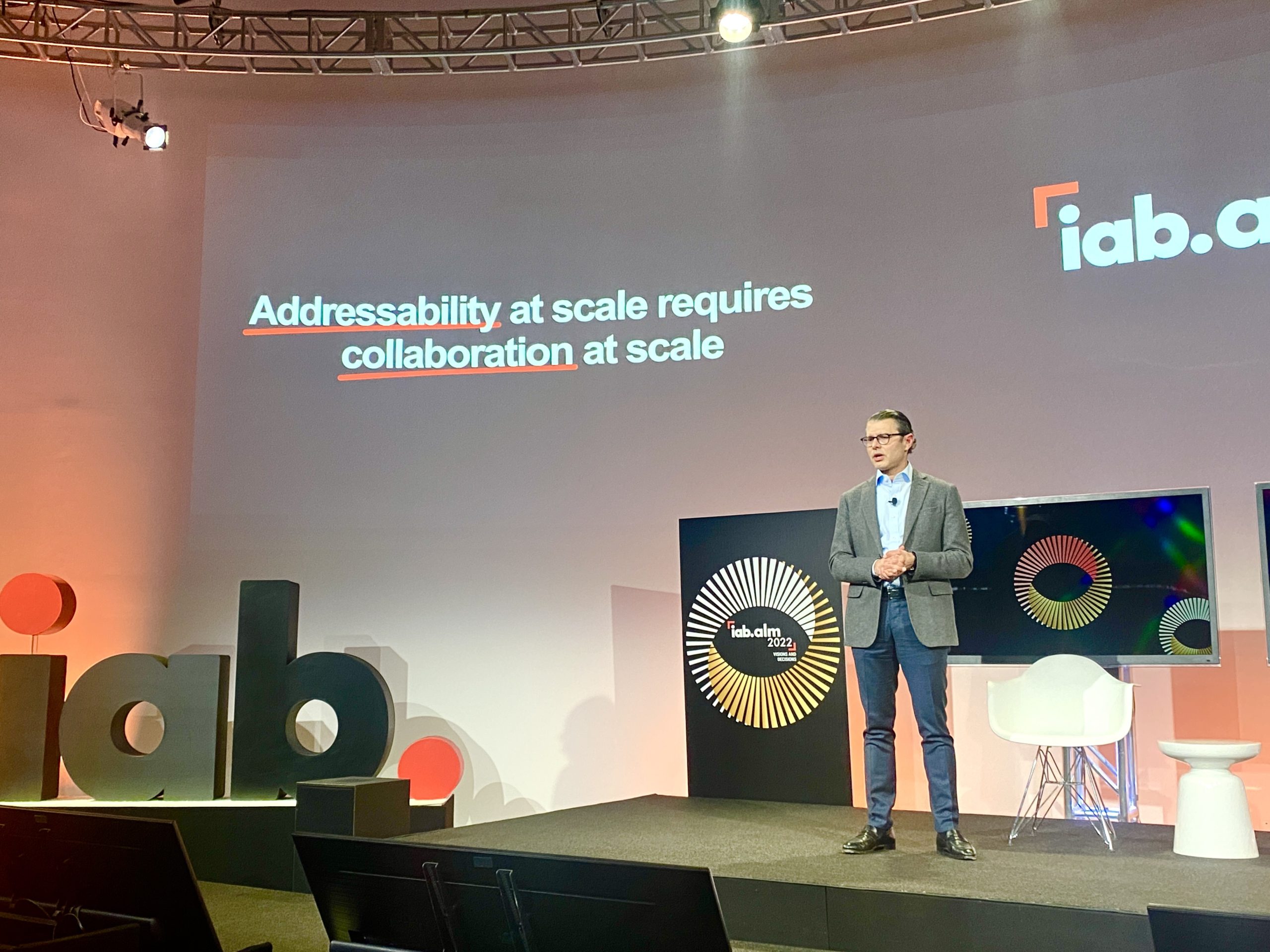
Reporting in from IAB ALM 2022, Product Marketing Lead Gavin Dunaway finds the top trends are ad reduction, the measurement morass, and retail media networks.
As the wrath of Omicron appeared to move on from NYC, the IAB’s 2022 Annual Leadership Meeting felt like an AdTech family reunion. We’re an industry that thrives when we mingle and debate in person (no matter how fun the Twitter back-and-forth can be), and there was plenty to argue about as the pandemic seems to be on the way out and some new normalcy is setting in.
The overarching theme of Visions and Decisions highlighted that the moment was ripe for bold innovations, but also tough choices. While the trends were numerous, here are three that really stood out to me—and no, the supposed fallout from the eventual demise of the cookie is not one of them. (THIRD-PARTY COOKIES WILL NEVER DIE, MWA HA HAHA HAHA!)
Less Ads Is More
Shari Bachstein, CEO of The Weather Company and GM of IBM Watson Advertising, raised a lot of eyebrows on Day 1 when she announced that the new Weather Channel mobile app would reduce its ad footprint by 42%. The decision to reduce the ads in the app was driven by an interesting combination of data-driven insight and gut feeling that content and sponsorship was out of balance.
Sheri Bachstein, Chief Executive Officer of @TheWeatherCompany & General Manager of @IBMWatson says they send out 2.5 billion alerts every month, all to help people stay safe! #ALM2022 pic.twitter.com/WIQnV8XgSf
— IAB (@iab) February 7, 2022
Less ads?!? Will someone please think about the revenue!
Oh, Bachstein and crew have: according to their data and predictive models, a short-term revenue “blip” (technical term, I hear) would be exceeded by improved consumer loyalty and advertiser satisfaction. Long-term revenue benefits were predicted to be more than worth a short-term fall. The Weather Company and Watson tend to know what they’re talking about when it comes to data and modeling.
But this wasn’t the only session where reduced ad loads were top of mind. During a closed-door town hall focusing on the relationship between monetization and consumer experience (sponsored by PubMatic and from which I’m only sharing larger themes), several publisher practitioners were experimenting with serving less ads to consumers, with some noticing that a lighter ad load turned to longer consumer sessions and increased pageviews.
This became even more nuanced—on certain properties, reduced ad loads led to more user engagement, while on others they had no effect. Some publishers even leveraged first-party user segments to determine which consumer groups were more receptive to higher ad loads.
For publishers, this is an area worthy of intense scrutiny and experimentation: multivariate testing employed in force. We all know you can only throw so many units on a page, but publishers can greatly benefit from determining the optimal number of units on a page—for both superb consumer experience and revenue.
Measurement Purgatory
I’ve got bad news if you were expecting a measurement hero to gallop into Cross-Screen Town on a beautiful steed. Nope, a tense panel of representatives from major measurement players (Nielsen, comScore, and VideoAmp) was a microcosm of the measurement mess. comScore’s Bill Livek made sure to bring up the importance of the Media Ratings Council (MRC), a dig at Nielsen’s lost accreditation. Moderator and IAB CEO David Cohen noted that VideoAmp CEO Ross McCray looked “visually uncomfortable” at one point.
“We’ve had low standards for a long time and it’s created a lot of waste,” McCray said. “It’s disgusting that publishers have such great inventory and only get credit for half.”
So why isn’t measurement aligned across the industry?
Gerber: You want the honest answer? Too many intermediaries that are making lots of money. @iab #ALB2022
— Gavin Dunaway (@MediaTrustGavin) February 8, 2022
Are panels a thing of the past or an essential part of the next measurement wave? What about CTV platforms reluctant to share data? The IAB again and again suggested a “multi-currency” measurement system was the way of the future; no surprise that Nielsen didn’t appear crazy about the idea, but a later panel on the omni-channel consumer journey also poured skepticism on the idea, claiming agencies (or really the major holding companies) needed to “make a measurement choice.”
The pandemic drove mass adoption of CTV streaming, and completely upended a measurement industry that was teetering to begin with. It seems the chaos is going to linger, and doubtful that a measurement hero will stride to our rescue.
Attention Shoppers: Retail Media Blowing Up
“For years digital advertising has promised precision while delivering wasted impressions.” That was one of many killer lines during an extremely bold presentation from Kroger Precision Marketing (KPM).
Right now: @IAB’s #ALM2022: A Vision for the New Era of Media Accountability. Cara Pratt and Amanda Rassi take the stage. If you share @Kroger’s mission to pave the way for a new era of media accountability… don’t miss this! pic.twitter.com/5o9dcoGse9
— IAB (@iab) February 8, 2022
Possibly the most fascinating developing trend in digital advertising is retail media networks—major retailers offering advertisers access to audiences on their digital properties as well as on third-party sites and apps. National and global retailers alike are building out their own tech stacks or outsourcing these operations to specialists like Criteo, CitrusAd, Quotient, and more. Just in the last few months, Home Depot, Family Dollar, and Tesco have all made headlines with their new retail media networks.
With retailers’ online traffic exploding during the pandemic, many have seen the opportunity to grab a healthy slice of the digital advertising market—especially with highly targetable mobile and in-app inventory in Apple’s data deserts. Outside of OG retail media network Amazon, eMarketer estimates that retail media will bring $9.2 billion in revenue in 2022.
Advertisers (especially CPG) are excited because of closed-loop attribution—the retailer uses its vast data supply to precisely target consumers, and they click and purchase. A challenge here, however, is ensuring that advertiser landing pages send consumers to the retailer’s properties; if not, then advertising is actually hurting the core retail business.
Hmmm—@Kroger Precision Marketing offering a vision for media accountability… We can’t indiscriminately scrape consumer data, can’t hide behind black-box algorithms. @iab #ALM2022
— Gavin Dunaway (@MediaTrustGavin) February 8, 2022
KPM has built up its in-house program over the last four years, fully stocked with data scientists at that. A great fear for any retailer is driving consumers away with annoying ads, but Kroger has mitigated that challenge. “We’re not adding clutter to consumers’ experience,” commented Cara Pratt, SVP of KPM. “We’re adding value to their experience, and they’re rewarding us for it.
So are other digital publishers worried that retail media is invading their turf? Someone in the crowd asked BET EVP and CMO Kimberly Evans Paige that very question and she didn’t miss a beat: of course not—premium publishers partner with retail media networks. For retailers to drive the most value out of their data and get the scale that advertisers demand, they need to have access to premium third-party inventory.
Stray Observations
- The New York Times employs more than 100 data scientists!
- The idea of Metaverse shopping is intriguing—imagine trying out clothes with your avatar. Though how much better is that than current augmented reality options? This reflects the constant question with the Metaverse—how is it exactly better than our current digital environments? I’m still not hearing great answers.
- Advertisers: can’t target consumers in Safari, iOS apps, and Firefox via third-party cookies? Why not use them as laboratories to run small-batch bold and experimental campaigns? The CPMs tend to be lower and last we checked, consumers can still click in those environments…
- Mindshare CEO Amanda Richman: Brand safety crusades have pushed advertisers away from diverse voices in media. Investing in media diversity and truly wide-ranging audiences is good for the bottom line.
- Tell us how you really feel:
“If you had a magic wand a could make any wish come true, what would you do?”
“Make Facebook and Google disappear.”@iab #ALM2022
— Gavin Dunaway (@MediaTrustGavin) February 7, 2022



